by Ethan Dropkin
While some of us have the benefit of working in engineered soils and ideal garden conditions, many designers and horticulturists have the unique and challenging task of greening our cities where growing conditions can be less favorable. Among many other benefits, planting in cities helps improve air quality, combats urban heat island effect, and creates habitat corridors for wildlife.
Unfortunately, all too often the urban jungle presents challenges that make designers resort to using a limited palette of largely exotic species. Such species can succeed despite the urban pressures put upon them, but they add little ecological value. Additionally, this limited palette creates a largely homogenous urban landscape unreflective of regional, climate, flora, and personality. Instead of adding to this vegetative homogeneity, we can turn extreme urban conditions into assets by looking to native plant communities that can thrive in, and contribute to, the urban environment.
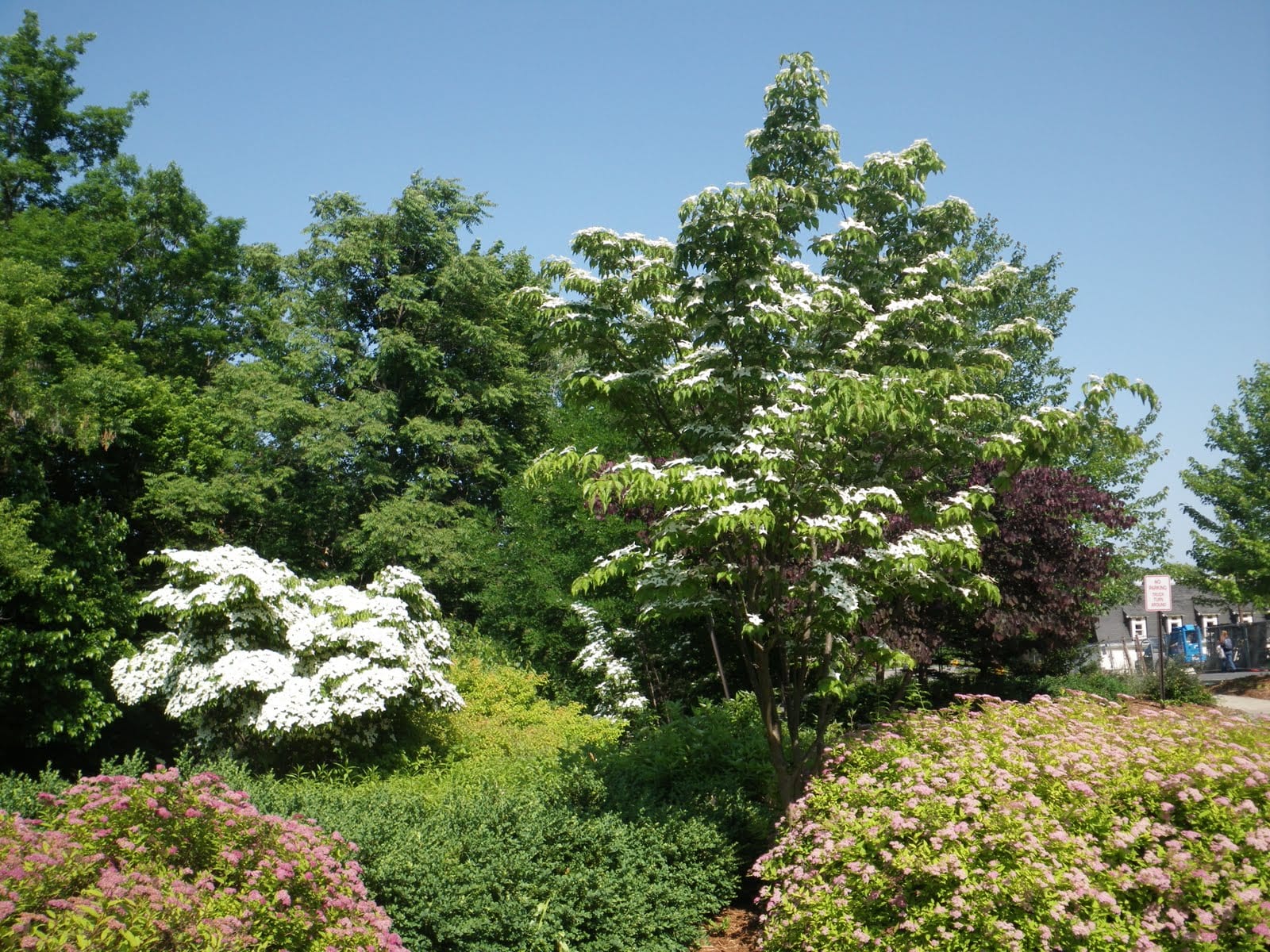
A representative example of the type of planting often found in urban environments comprised largely of “bullet-proof” non-native species. They survive and add green to the concrete, but don’t offer much ecological value or help to fix a city geographically with regionally unique vegetation.
Challenges of the Urban Environment
The challenges facing urban plants include, but are not limited to:
- Reflected heat load – Building materials reflect heat that desiccates plants.
- Salt runoff, salt spray, and salinated soils – Over-salted roadways and sidewalks drain into planting areas, and cars and snowplows spray or dump salt onto plants and soils.
- Flooding – Excess water drowns plants and introduces salt, petroleum, and other growth inhibiting chemicals into soils.
- Soil Compaction – Soil density reduces soil porosity and oxygen levels, limiting the ability of plants to grow healthy root systems.
- High pH soils – Building materials in cities, such as concrete, leach high pH elements into soils, restricting plant’s access to nutrients.
- Dog urine – Urea and salt damage planting soils.
Many of these problems have a serious, long-lasting impact on the diversity of species we can use successfully in urban plantings. However, by drawing from plant communities that have adapted to similar conditions, we can turn challenges into opportunities to create more diverse, productive urban flora.
Street Trees – Floodplain Forests
A classic example of leveraging the evolved flexibility of a plant community for the conditions of the urban environment is in street tree species selection. The main issue plants in tree pits face is lack of root access to oxygen. Most of the available soil is buried under asphalt and concrete, and any minimally available bare soil is compacted by foot traffic.
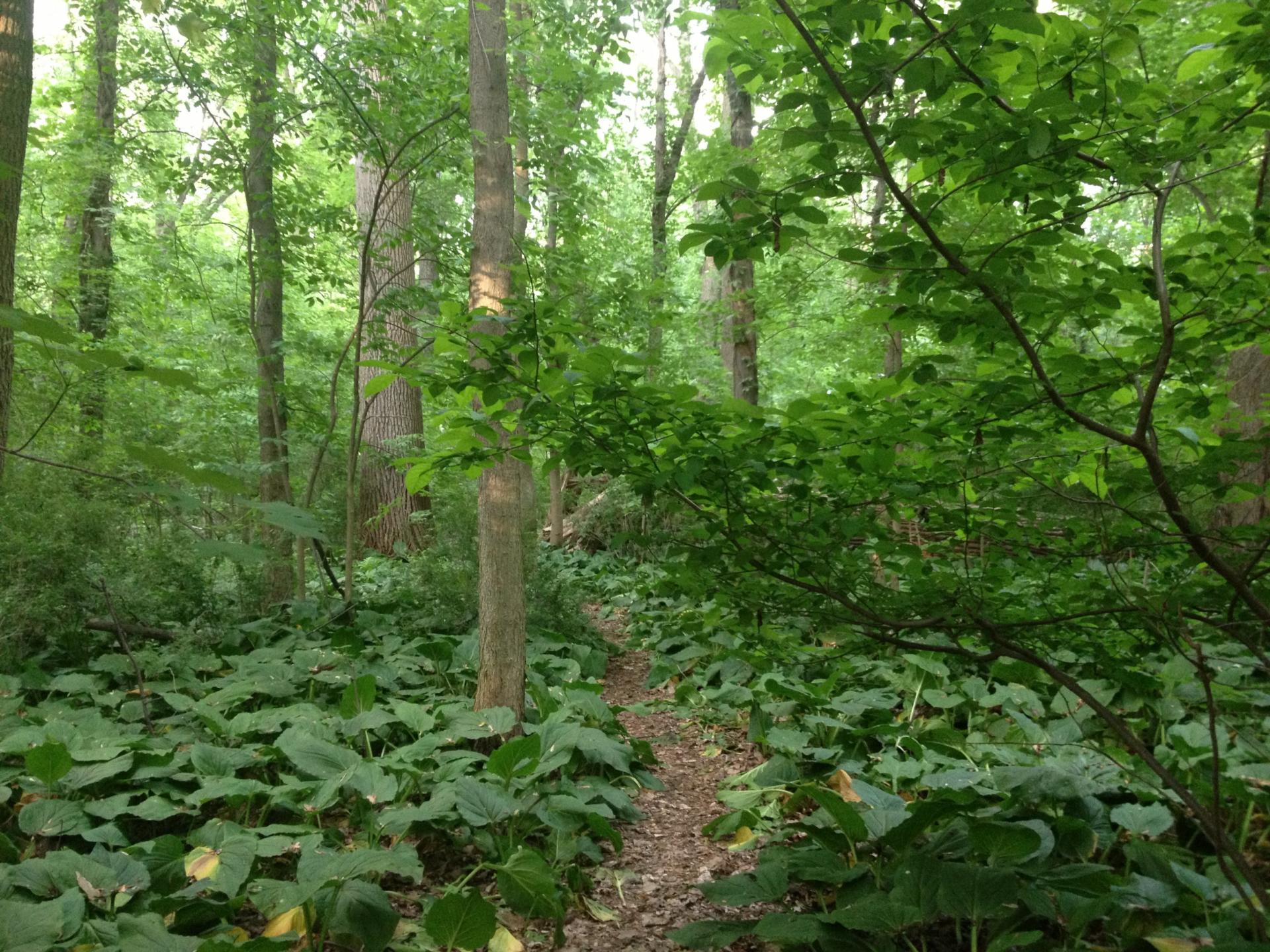
Floodplain forests experience annual inundation, so the trees have adapted to grow in water-logged soils that contains little oxygen for months at a time. Drought is also an urban condition, and the flood/drought cycle to which floodplain trees have adapted makes them well suited for the street tree environment.
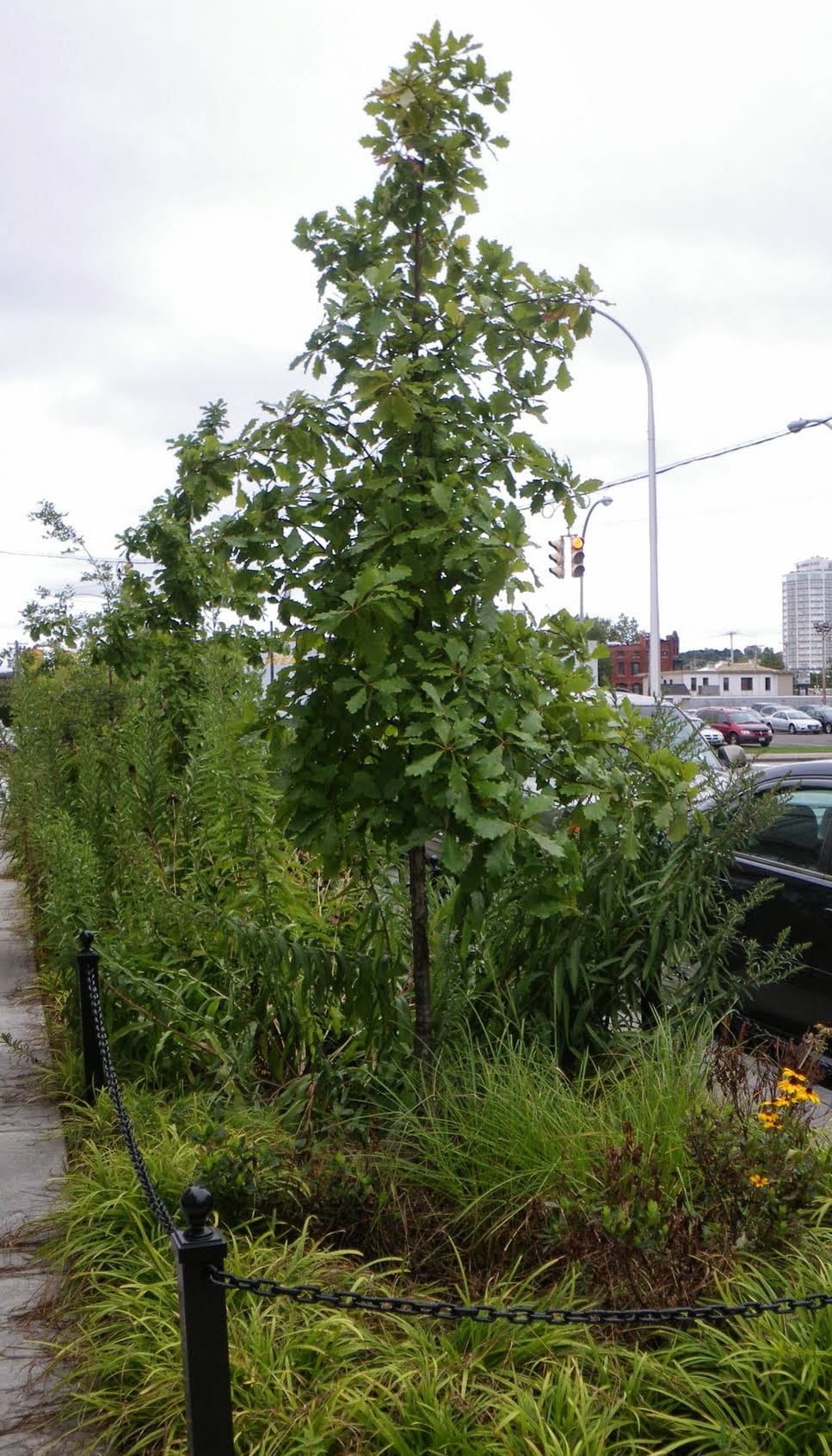
Swamp White Oak is a particularly favorite street tree of mine because unlike other oaks, it thrives in high pH; unlike most other oaks, it is relatively easy to transplant, it is tolerant of flood and drought once established; and yet, like most other oaks, it provides massive ecological value (particularly important in cities) as a lepidopteran host plant and as an acorn food source for insects, birds, and mammals.
Somewhat counterintuitively, the closest plant community analogue to a tree pit is a floodplain forest. Floodplain forests experience annual inundation, so the trees have adapted to grow in water-logged soils that contain little oxygen for months at a time. Drought is also an urban condition, and the flood/drought cycle to which floodplain trees have adapted makes them well suited for the street tree environment.
Some successful native floodplain/street trees include:
- Taxodium distichum – Bald Cypress
- Gymnocladus dioicus – Kentucky Coffeetree (for a street tree, the fruitless male cultivar ‘Espresso’ is often preferred)
- Gleditsia triacanthos inermis – Thornless Honeylocust
- Tilia americana – Basswood
- Quercus phellos – Willow Oak
- Quercus bicolor – Swamp White Oak (my personal favorite)
These species share one additional trait that makes them particularly well adapted to the urban environment: they are not affected by high pH soils and therefore are less likely to experience issues related to nutrient unavailability (which high pH soils can cause in some plants).
Stormwater Infiltration – Shrub Swamps

Similar to floodplain forests, plants of shrub swamps have evolved to tolerate both extended inundation and periods of drought. Plants from these communities are ideal for use in urban stormwater retention areas, such as rain gardens and bioswales.
Similar to floodplain forests, plants of shrub swamps have evolved to tolerate both extended inundation and periods of drought. Plants from these communities are ideal for use in urban stormwater retention areas, such as rain gardens and bioswales.
Shrubs are ideal for rain gardens and bioswales because they generally need less annual maintenance than herbaceous plantings. Due to their woody structure, they are more physically substantial than herbaceous plantings, so they are potentially less likely to get walked on, driven over, or otherwise damaged.
The biggest mistake in plant selection for stormwater infiltration practices is to rely on plants that need consistently saturated soils. Rain gardens and bioswales are designed to hold standing water for no more than 24 hours—usually for far shorter periods.
Salt and pH are also both important considerations for plants in soils meant to collect and infiltrate stormwater, as water carries both high pH leachate and dissolved salts into these systems.
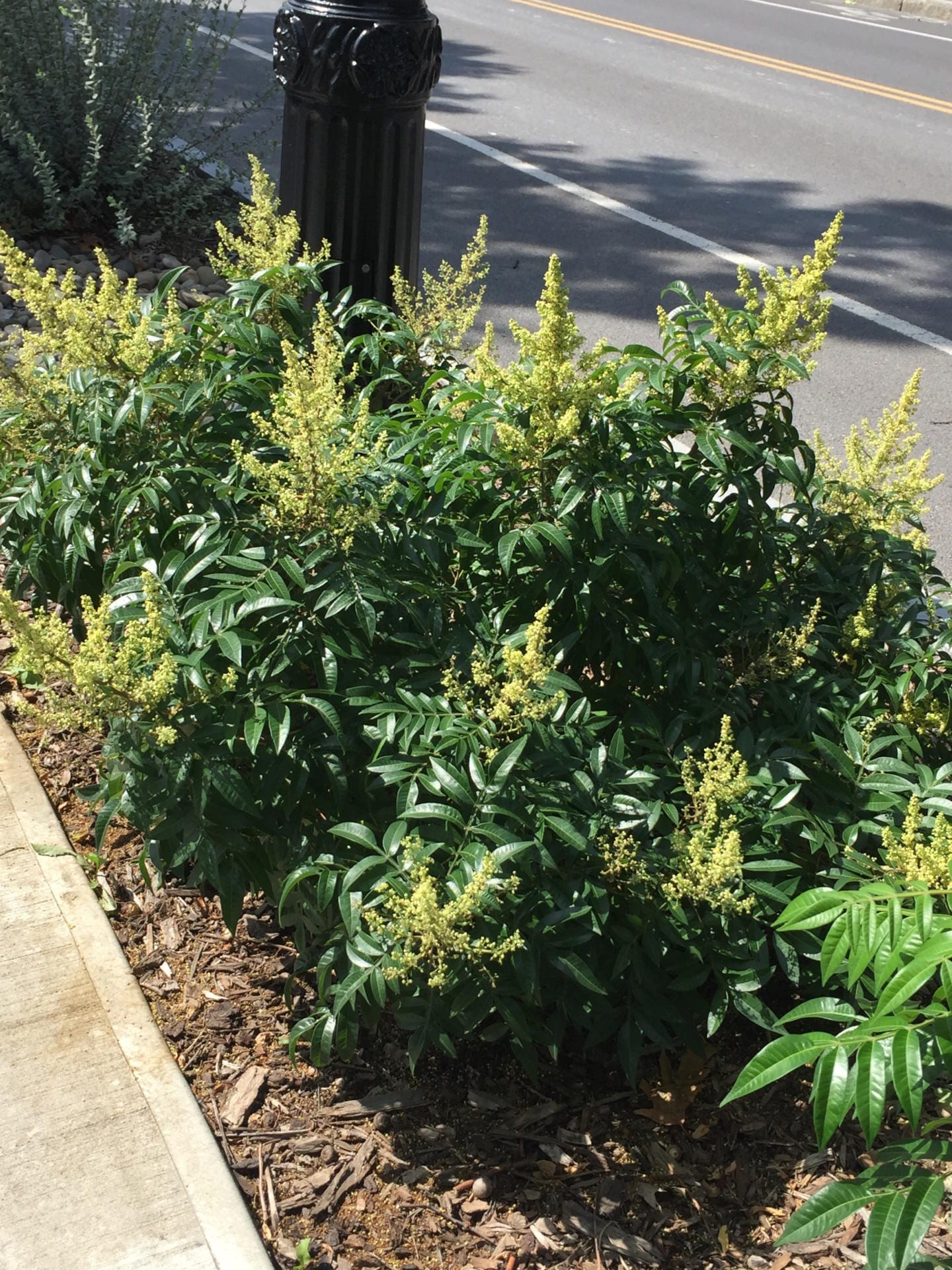
Rhus copallinum is one of the first non-saltmarsh endemic species you begin to see in the high saltmarsh, which belies both its tolerance of salt and soil inundation. As a clonal shrub it is tolerant of regular coppicing (every 3 years or so) to keep down its height, and it can spread to fill areas, helping to suppress weed species. In addition, it bears glossy leaves through the growing season, has unparalleled scarlet fall color, and both its flowers and fruits are useful to pollinators and birds respectively.
Species selection and placement can help ensure that the right plants are placed where they will perform best. A pamphlet I co-authored with Dr. Nina Bassuk, Woody Shrubs for Stormwater Retention Practices (Northeast and Mid-Atlantic Regions, 2nd edition), is available for free online and includes a long list of native and non-native shrubs for use in swales and other stormwater retention areas. From this list, I most strongly recommend:
- Baccharis halimifolia – Groundseltree
- Cephalanthus occidentalis – Buttonbush (particularly tidy, semi-dwarf cultivars like ‘Sugar Shack’ and ‘Moonlight Fantasy’)
- Hypericum sp. – St. Johnswort sp. (specifically, H. frondosum, kalmianum, and prolificum)
- Morella pensylvanica – Northern Bayberry (‘Silver Sprite’ is semi-dwarf to 5’)
- Rhus copallinum – Shining Sumac
- Rosa palustris – Swamp Rose
- Salix candida – Sageleaf Willow (‘Silver Fox’ is a dwarf cultivar to 3’)
There are many other plants that can be used, but all of the species on this list are flood/drought tolerant and high pH tolerant. Additionally, Baccharis, Morella, Rhus copallinum, and Cephalanthus all have relatively high tolerance to saltwater/spray and salinated soils (especially the first two species).
I have also specifically listed dwarf cultivars where they exist. While cultivar use may be controversial, a small, tidy shrub without maintenance or safety issues could mean the difference between success and failure for a sidewalk inset stormwater infiltration planting. While stormwater infiltration is of utmost importance for these interventions, using native species can also ensure the potential for ecological function for pollinators and other species. For instance, Cephalanthus occidentalis, the Hypericum species, and Rosa palustris are all particularly prized by native bees and other pollinators.
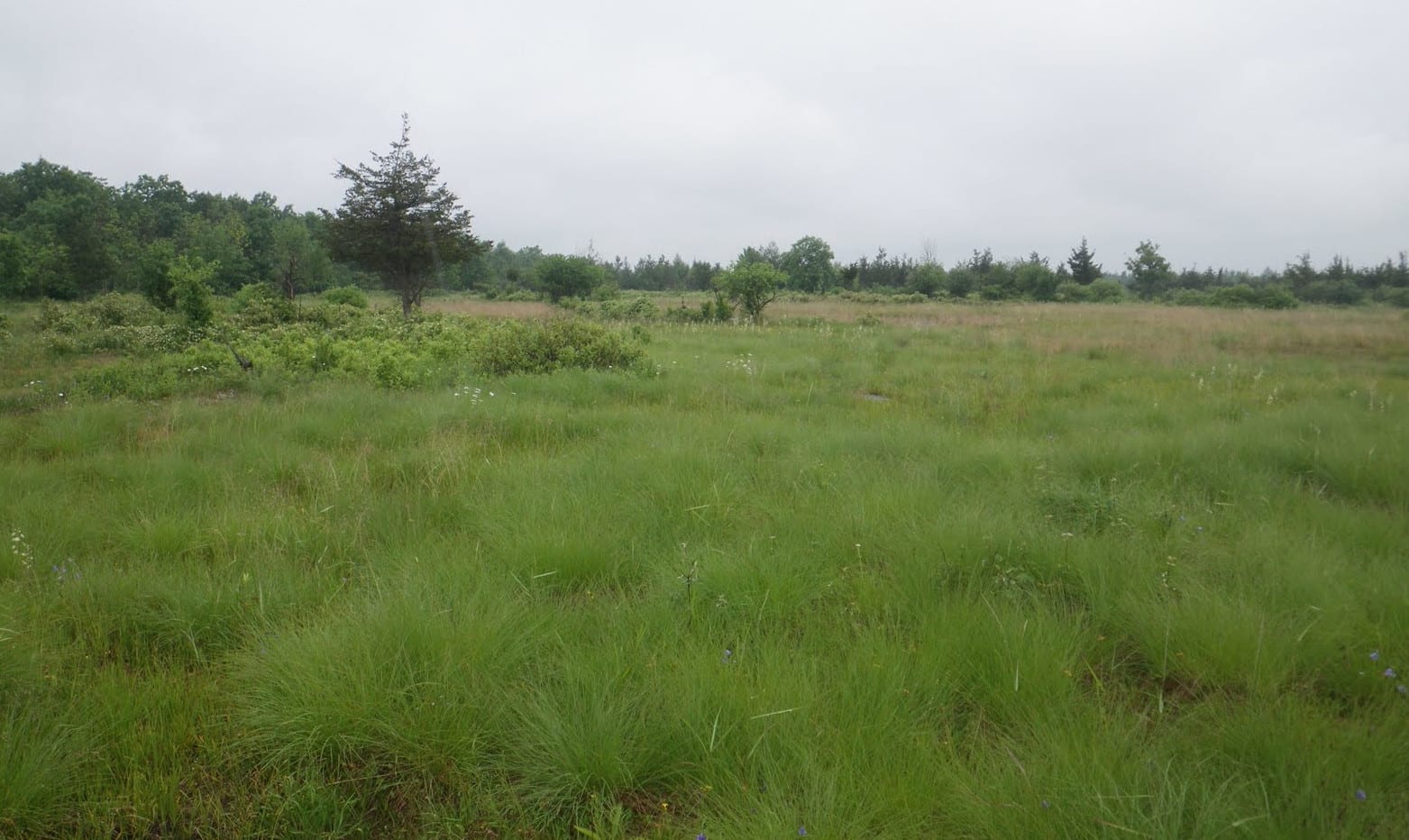
Pavement barrens are communities of glacier scoured bedrock which have generated very thin, patchy soil cover since the glaciers receded. They can be acidic or basic in pH depending upon the type of bedrock they develop upon. Alvars, like the one pictured here, occur on high pH bedrock and provide a rich plant palette for green roofs and other urban planting conditions that have thin high pH soils. The foreground of this image is dominated by Sporobolus heterolepis, a rare native grass in the East, prized in horticulture for its fine leaf texture and low, mounding habit.
Green roofs – Pavement Barrens
Green roofs are some of my favorite urban landscapes to work on, in part because the best analogue communities are pavement barrens. Plants in pavement barrens grow on very shallow soil profiles (often a few inches or less of soil) over bedrock. They are accustomed to periods of prolonged drought (and brief periods of flooding during and after rain events); extreme solarization; high pH soils (in the case of alvars and limestone barrens); and thin, nutrient poor soils. All of these characteristics make them ideal candidates for use on green roofs. In addition, the growth suppressive conditions of pavement barrens tend to support a greater diversity of rare plants. While it is cheap and easy to make sedum green roofs, they are both ecologically deficient and aesthetically monotonous. Pavement barren plants can create a site-appropriate palette that includes both ecologically valuable and rare plants, making a green roof that is multifunctional and beautiful. While there are a host of appropriate native plants for green roofs, some of the best performers include:
- Echinacea tennesseensis – Tennessee Coneflower
- Monarda citriodora/M. punctata – Lemon Beebalm/Horsemint (an annual and a biennial respectively that reseed readily in green roof conditions)
- Penstemon hirsutus – Hairy Beardtongue
- Phemeranthus calycinus – Fame Flower
- Ruellia humilis – Wild Petunia
- Solidago nemoralis – Gray Goldenrod
- Solidago ptarmicoides – Upland White Goldenrod
- Sporobolus heterolepis – Prairie Dropseed
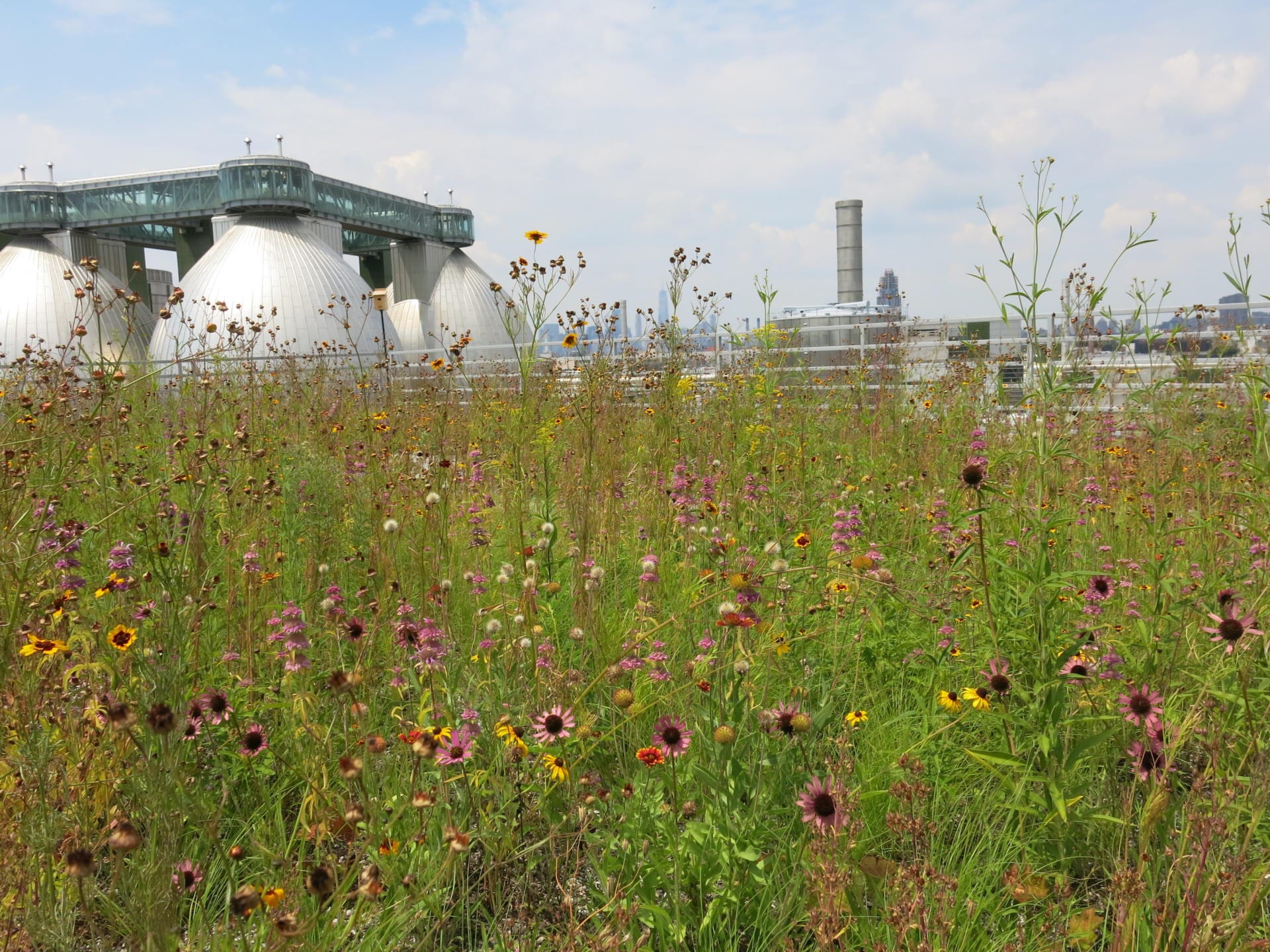
This green roof in Brooklyn took the alvar plant palette as inspiration. Here we see the Sporobolus from the alvar used to great success horticulturally, though it is a rarity in New York State. Additionally, the globally rare Echinacea tennesseensis, an endemic species to the high pH cedar glades of central Tennessee, is growing beautifully in the thin, high pH gravel of the green roof. These examples help to illustrate how green roofs can be a haven for rare plants in the very centers of our most built up, anthropocentric environments.
Conclusion
Whether at ground level or high above the city streets, growing plants in an urban setting admittedly poses challenges. However, by using existing plant communities to guide us, we can use urban conditions to our advantage and create resilient, productive native plantings that add beauty and ecological function to our cities.
About the Author
Ethan Dropkin was born in New York City but grew up in the fold between the Hudson River and the Catskill Mountains in southern New York State. It was in this rural setting that his love of native plants and landscapes was cemented from an early age. He works as a Landscape Designer at Larry Weaner Landscape Associates and before that was at Michael Van Valkenburg Associates, also in a designer role. He has a Master’s in Landscape Architecture and a Master’s of Professional Studies in Horticulture, both from Cornell University. While at Cornell, he co-authored the paper, Woody Shrubs for Stormwater Retention Practices, a free resource for laypeople and professionals on creating planted stormwater retention systems. He has interned at Cornell’s Botanic Garden in the Mundy Wildflower Garden, Minn’s Garden (Cornell’s Horticulture Department display garden), worked as a gardener for the New York City Parks Department in Brooklyn, N.Y., and co-taught a Landscape Design course through Cornell’s cooperative extension service. He delights in native plants, landscapes, and wildlife and strives to work in support of all three.
***
Each author appearing herein retains original copyright. Right to reproduce or disseminate all material herein, including to Columbia University Library’s CAUSEWAY Project, is otherwise reserved by ELA. Please contact ELA for permission to reprint.
Mention of products is not intended to constitute endorsement. Opinions expressed in this newsletter article do not necessarily represent those of ELA’s directors, staff, or members.

